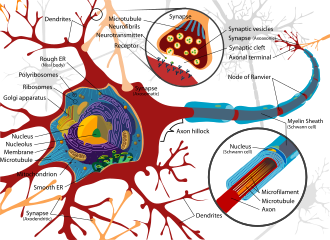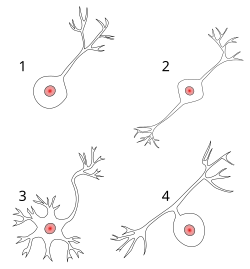Neuron
Neuron is a functional and anatomical unit of the nervous system. Humans have 15-25 billion neurons and 300 billion contact surfaces, called synapses. A neuron is able to receive a particular form of signal and respond with special signals, conducting them and making special functional contacts (synapses) with other neurons, effectors or receptors.
Structure[edit | edit source]
A nerve cell consists of a body (soma, perikaryon) and two types of processes, afferent dendrites and efferent neurites (axons).
Soma[edit | edit source]
The body of the neuron is bounded by the plasma membrane, contains receptors and ion channels. This structure determines the generation and propagation of excitations. The body of the neuron contains the nucleus, Nissl substance (granular endoplasmic reticulum) and mitochondria.
Protrusions[edit | edit source]
Dendrites[edit | edit source]
Dendrites receive input information (at the same time it is a trophic segment). They are usually short, richly branched, and extended into dendritic spines that serve to modulate the postsynaptic potential as it transitions from synapse to dendrite. Neurochemically, they are very rich in chemically controlled ion channels.
Neurites[edit | edit source]
Neurites are long processes leading excitations from the body of the neuron (to the next neuron or effector), i.e. efferently. They contain ribosomes, a small number of mitochondria and neurotubules. Neurochemically, they are rich in voltage-gated ion channels. The site of neurite outgrowth is the axon bump; this, together with the initial segment of the neurite, is the site of action potential generation.
Myelinated neurites (= axones)[edit | edit source]
The myelinated section occurs along the entire length of the axon except for its beginning and terminal branching. It is important for the transmission of excitement, the thicker the axon, the faster the transmission. Throughout, the myelin sheath is interrupted by Ranvier notches, with the sections between each notch called internodes. The speed of conduction is directly proportional to the length of the internodes. In the PNS, the extracellular space at the site of the Ranvier notch is separated from the surroundings by a continuous basement membrane that bridges over the notch area; in the CNS, astrocyte processes are directly seated there.
Non-myelinated neurites[edit | edit source]
The main function of the neurite is the transport of certain substances from the body to the telodendrites, which is dependent on a developed system of neurofilaments and neurotubules. We distinguish between anterograde transport (from the cell body) and retrograde transport (into the cell body - spread of viruses and toxins).
Types of neurons[edit | edit source]
Neurons can be divided morphologically, according to the length of the axon and functionally.
- Morphological:
- multipolar (containing many small, richly branching dendrites);
- bipolar (contains one relatively long dendrite and axon, sensory neurons (skin, auditory, olfactory) and nociceptive fibres);
- unipolar;
- pseudounipolar (has a long dendrite that merges with the axon).
- According to the length of the axon:
- Golgi type I - neurons with long neurites;
- Golgi type II - neurons with short neurites.
- Functional:
- Principal (projection) - they connect distant areas of the nervous system;
- local (interneurons) - connect nearby areas.
Links[edit | edit source]
Related articles[edit | edit source]
External links[edit | edit source]
- JANČÁLEK, Radim – DUBOVÝ, Petr. Základy neurověd v zubním lékařství [online]. MEFANET, ©2011. The last revision 27.10.2011, [cit. 26.11.2011]. <http://portal.med.muni.cz/clanek-560-zaklady-neuroved-v-zubnim-lekarstvi.html>.
Used literature[edit | edit source]
- TROJAN, Stanislav, et al. Lékařská fyziologie. 4. edition. Grada Publishing, a.s., 2003. ISBN 80-247-0512-5.




